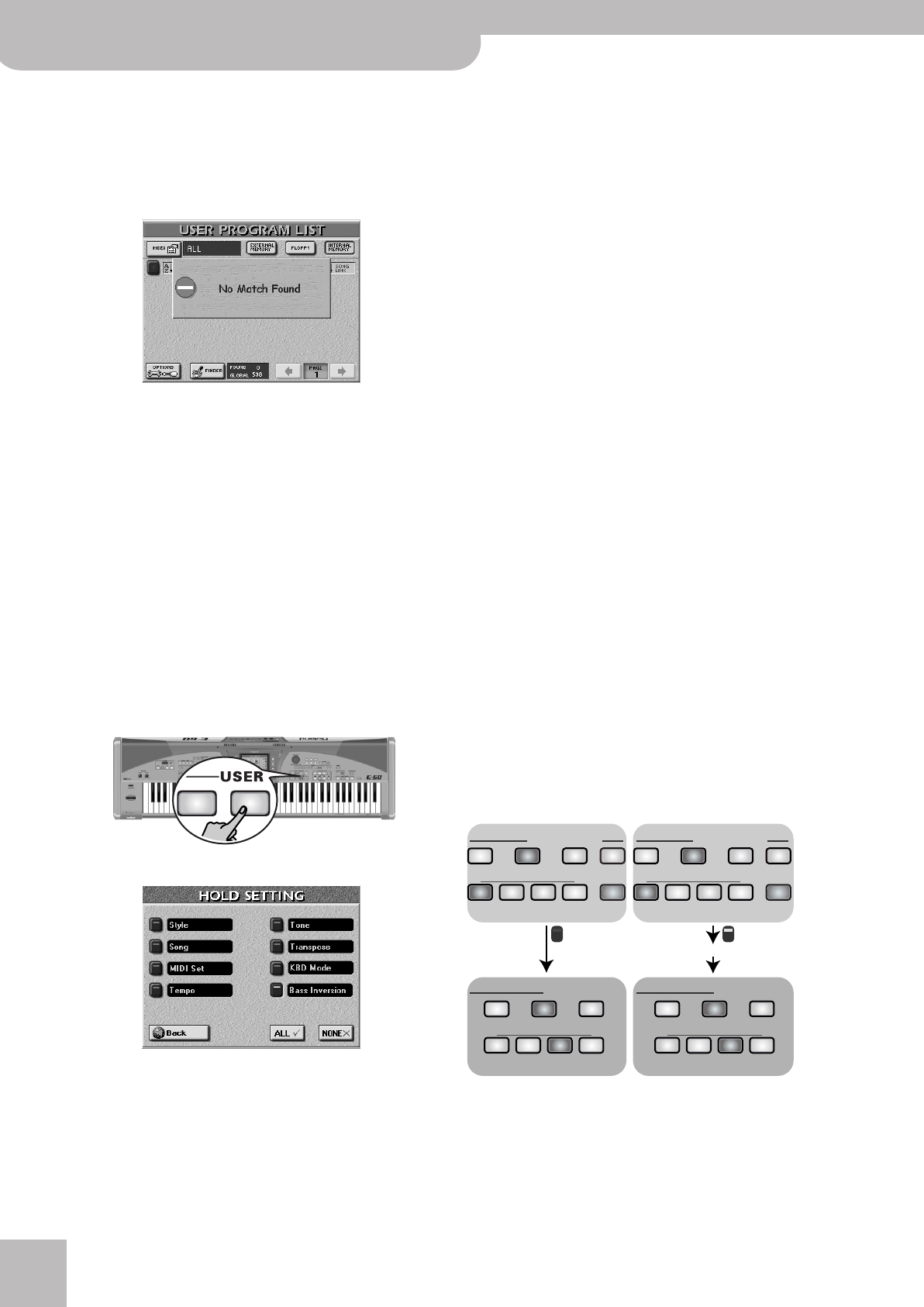
Working with User Programs
92
r
E-60/E-50 Music Workstation
(8) Press the [FIND] field to start your search.
(9) Press the field of the User Program you need and
start playing.
Note: If no User Programs were found, the following message
appears and no file names are displayed (in which case you
need to press the [USER¥PRG], [STYLE¥LINK], [GENRE] or
[SONG¥LINK] field to display all User Programs again):
If the E-60/E-50 did find one or several matches, the
“FOUND” number will be smaller than the “GLOBAL”
number.
Note: See also “Editing User Program Finder information” on
p. 95 for how to make the Finder functionality even more pow-
erful.
Selectively loading User Program settings
(User Program Hold)
Your E-60/E-50 allows you to filter certain User Pro-
gram settings when new User Programs are loaded.
(1) If you need a different User Program (whose set-
tings should be used), first select it.
(2) Press the [LIST] button and the [HOLD¥SETTINGS]
field.
—or—
Press and hold the [HOLD] button.
The display changes to:
(3) Press the fields of the settings you do not want to
recall.
● Style—Press this field if the settings related to the
Arranger (Style and Division) should be ignored.
● Song—Press this field if the song (see “Song Link” on
page 93) should no longer be loaded.
● MIDI Set—Press this field if the linked MIDI Set
(page 94) should not be recalled. The current MIDI chan-
nels, filter settings, etc. (page 187), therefore remain as
they are.
● Tempo—Press this field if the tempo setting contained in
every User Program should be ignored.
● Tone—Press this field to ignore sound selection for the
Keyboard parts when a different User Program is
recalled.
● Transpose—Press this field to ignore the Transpose
(value and mode) contained in every User Program.
● KBD Mode—Press this field to ignore the Keyboard
Mode (Whole/Split) and Arranger Chord settings (Stan-
dard/Piano Style, Left/Right, etc.).
● Bass Inversion—Press this field to ignore the setting of
the [BASS¥INVERS] button.
Press [ALL] to activate all button icons and [NONE] to
switch them all off.
Pressing one of the above fields without selecting a
User Program afterwards has no effect. Only when
you select another User Program will the selected
data filter start working.
(4) Press the [EXIT] button to return to the main page.
(5) Use the USER PROGRAM [HOLD] button to decide
whether the filters you selected should be used
(button lights) or not (button dark).
Bypassing the AUTO FILL function (Fill In On
User Program Change)
User Programs also contain the “address” of the Style
division (pattern) to be used when you recall those reg-
istrations. By selecting a User Program, you may there-
fore switch from the VARIATION [1] pattern (which you
selected by hand) to VARIATION [3] (stored in the new
User Program), for example.
If the [AUTO¥FILL¥IN] button lights, any “automated”
changes to another Style pattern are usually preceded
by a fill-in phrase (see the right illustration):
If [AUTO¥FILL¥IN] doesn’t light, the change to VARIA-
TION [3] occurs as soon as you select the User Program
in question.
LIST
HOLD
FILL IN ON USER
PROGRAM CHANGE
FILL IN ON USER
PROGRAM CHANGE
1234
VARIATION
AUTO
FILL IN
END/RIT
INTRO
STYLE CONTROL
MAIN
1234
VARIATION
END/RIT
INTRO
STYLE CONTROL
MAIN
1234
VARIATION
END/RIT
INTRO
STYLE CONTROL
MAIN
BASS
INVERS
1234
VARIATION
AUTO
FILL IN
END/RIT
INTRO
STYLE CONTROL
MAIN
BASS
INVERS
Current setting on the front panel
Setting stored in the User Program
First plays a fill
Direct change
E-60_50_OM_UK.book Page 92 Thursday, June 22, 2006 10:06 AM
